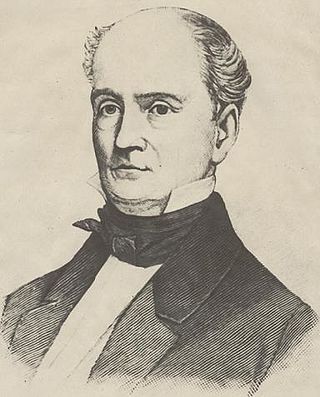Related Research Articles

The 2nd United States Congress, consisting of the United States Senate and the United States House of Representatives, met at Congress Hall in Philadelphia, Pennsylvania, from March 4, 1791, to March 4, 1793, during the third and fourth years of George Washington's presidency. The apportionment of seats in the House of Representatives was based on the provisions of Article I, Section 2, Clause 3 of the United States Constitution. Additional House seats were assigned to the two new states of Vermont and Kentucky. Both chambers had a Pro-Administration majority.

Vermont has been represented in the United States House of Representatives by a single at-large congressional district since the 1930 census, when the state lost its second seat, obsoleting its 1st and 2nd congressional districts. There were once six districts in Vermont, all of which were eliminated after various censuses.

Israel Smith was an American lawyer and politician. He held a wide variety of positions in the state of Vermont, including as a member of the United States House of Representatives, a member of the United States Senate, the fourth governor of Vermont.

William Adams Palmer was an American lawyer and politician. A prominent of the Anti-Masonic Party in the 1830s, he was most notable for his service as a United States Senator from Vermont (1818–1825) and the 13th governor of Vermont (1831–1835).

The Vermont House of Representatives is the lower house of the Vermont General Assembly, the state legislature of the U.S. state of Vermont. The House comprises 150 members, with each member representing around 4,100 citizens. Representatives are elected to a two-year term without term limits.

The Vermont Senate is the upper house of the Vermont General Assembly, the state legislature of the U.S. state of Vermont. The senate consists of 30 members elected from multi-member districts. Each senator represents at least 20,300 citizens. Senators are elected to two-year terms and there is no limit to the number of terms that a senator may serve.

William Slade Jr. was an American Whig and Anti-Masonic politician. He served as a U.S. Representative from Vermont from 1831 to 1843, where he was an outspoken opponent of slavery. He was the 17th governor of Vermont.
The Vermont Democratic Party is the affiliate of the Democratic Party in the U.S. state of Vermont.

Elections in Vermont are authorized under Chapter II of the Vermont State Constitution, articles 43–49, which establishes elections for the state level officers, cabinet, and legislature. Articles 50–53 establish the election of county-level officers.

The 2000 Vermont gubernatorial election took place on November 7, 2000. Incumbent Democratic governor Howard Dean won re-election. The campaign was dominated by the fallout from the passage of a civil union bill and the subsequent backlash encapsulated by the slogan Take Back Vermont. Ruth Dwyer, the Republican nominee in 1998, ran again in 2000 and was closely tied to the Take Back Vermont movement. Howard Dean, the Democratic governor, favored civil unions and was a primary target of Take Back Vermont.

The 2010 United States House of Representatives election in Vermont was held on November 2, 2010 and determined who would represent the state of Vermont in the United States House of Representatives. Democratic Congressman Peter Welch decided to run for a third term in Congress, facing Republican Paul D. Beaudry and two independent candidates. Welch won over his three opponents by a healthy margin, which allowed him to represent Vermont in the 112th Congress.
James Madison Slade was a Vermont politician who served as the 21st lieutenant governor of Vermont from 1856 to 1857.

The 2016 Vermont gubernatorial election took place on November 8, 2016, and elected the governor of Vermont, concurrently with the 2016 U.S. presidential election, as well as elections to the United States Senate in other states and elections to the United States House of Representatives and various state and local elections. Incumbent Democratic governor Peter Shumlin was eligible to run for re-election to a fourth term in office, but opted to retire instead.

A general election was held in the U.S. state of Vermont on November 4, 2014. All of Vermont's executive officers were up for election as well as Vermont's at-large seat in the United States House of Representatives. Primary elections were held on June 3, 2014.

The 1900 Vermont gubernatorial election took place on September 4, 1900. Incumbent Republican Edward C. Smith, per the "Mountain Rule", did not run for re-election to a second term as Governor of Vermont. Republican candidate William W. Stickney defeated Democratic candidate John H. Senter to succeed him.

The 1988 United States Senate election in Vermont took place on November 8, 1988. Incumbent Republican Robert Stafford did not run for re-election to another term in the United States Senate. Republican candidate Jim Jeffords defeated Democratic candidate Bill Gray to succeed him.

A general election was held in the U.S. state of Vermont on November 5, 2002. All of Vermont's executive officers were up for election as well as Vermont's at-large seat in the United States House of Representatives.

A general election was held in the U.S. state of Vermont on November 2, 2004. All of Vermont's executive officers were up for election as well as Vermont's at-large seat in the U.S. House and Class 3 U.S. Senate seat. The 2004 presidential election was also held at the same time.

The 1845 Vermont gubernatorial election was held on September 2, 1845.
William Canfield is an American politician. He represents the Rutland-3 district in the Vermont House of Representatives.
References
- ↑ "William Notte". Ballotpedia. Retrieved 2024-02-04.